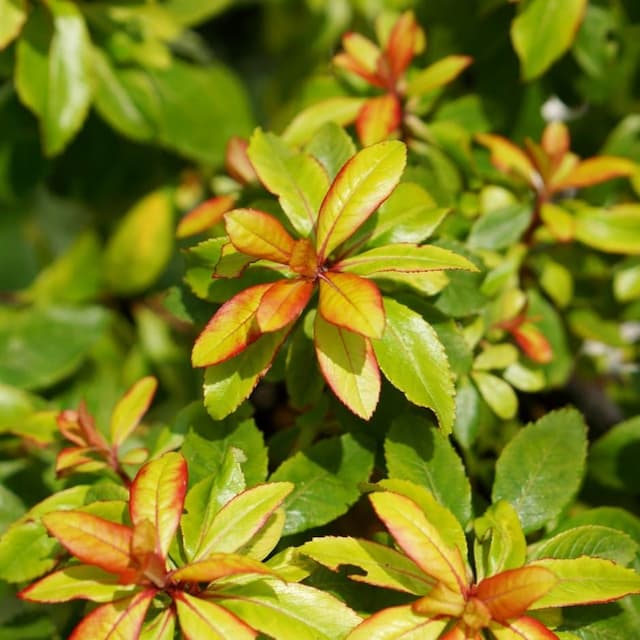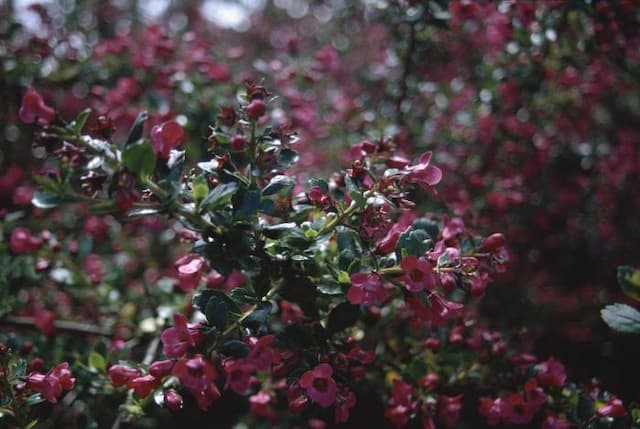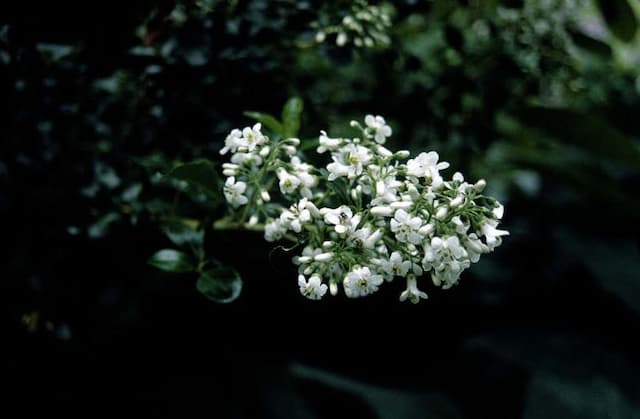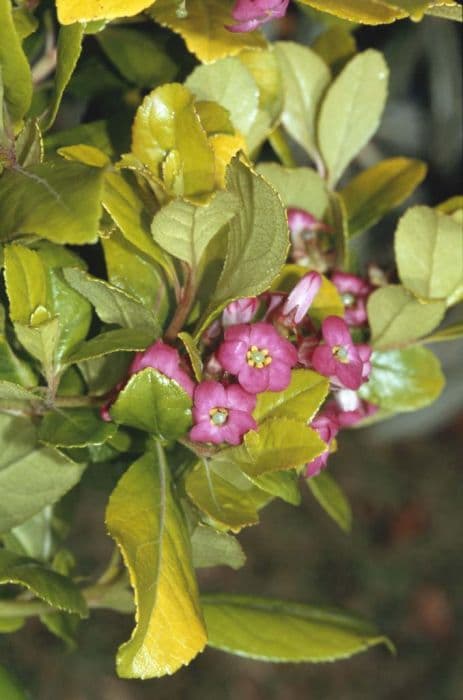Escallonia Escallonia 'C.f. Ball'

ABOUT
Escallonia 'C.F. Ball' is a striking evergreen shrub that is cherished for its dense, glossy, dark green foliage. The leaves are small and leathery, with a serrated edge, creating a textured appearance along the branches. During its blooming season, the plant is adorned with an profusion of small, tubular flowers that come in a vibrant shade of pink, clustered together to create a showy display. These flowers are particularly attractive to pollinators such as bees and butterflies, adding to the plant's ornamental value. The branches of the Escallonia 'C.F. Ball' are slightly arching, giving the shrub a lush, full-bodied look. This bushy plant has a natural rounded shape and can serve as an eye-catching feature in a garden setting, often used in hedges or as a stand-alone specimen. Overall, the Escallonia 'C.F. Ball' exudes a robust presence, with its rich greenery and delightful pink blossoms contributing an air of elegance and charm to any landscape in which it is planted.
About this plant
 Names
NamesFamily
Escalloniaceae
Synonyms
Escallonia, Red Escallonia
Common names
Escallonia 'C.f. Ball'.
 Toxicity
ToxicityTo humans
The Escallonia plant is generally considered non-toxic to humans. Ingesting parts of the Escallonia should not cause poisoning or serious adverse health effects. However, it is always advisable to refrain from eating ornamental plants due to potential individual allergies or gastrointestinal discomfort that can occur from ingesting plant material that is not typically used for food.
To pets
Escallonia is also regarded as non-toxic to pets. This means that cats, dogs, and other domestic animals are unlikely to experience poisoning symptoms from ingesting parts of the Escallonia. Nevertheless, it is always a good practice to prevent pets from eating plants, as they might cause digestive upset or an allergic reaction in sensitive individuals.
 Characteristics
CharacteristicsLife cycle
Perennials
Foliage type
Evergreen
Color of leaves
Green
Flower color
Pink
Height
5 feet (1.52 meters)
Spread
5 feet (1.52 meters)
Plant type
Shrub
Hardiness zones
7
Native area
South America
Benefits
 General Benefits
General Benefits- Attractive Flowers: Escallonia 'C.F. Ball' blooms with clusters of pink flowers that can add aesthetic value to gardens and landscapes.
- Hedge Plant: It can be used as a hedge due to its dense growth habit, providing privacy and reducing noise pollution.
- Low Maintenance: This plant is relatively easy to care for, requiring minimal pruning and upkeep once established.
- Drought Tolerance: Once established, Escallonia 'C.F. Ball' can tolerate periods of drought, making it suitable for xeriscaping and low-water gardens.
- Pollinator Attraction: The flowers attract bees and other pollinators, supporting biodiversity in the garden environment.
- Evergreen Foliage: It provides year-round greenery, offering garden structure and consistent coverage throughout the seasons.
- Wind Resistance: The plant can act as a windbreak, protecting more delicate plants and creating a sheltered microclimate.
- Versatility in Landscaping: It can be planted in flower beds, borders, or as a standalone feature, offering flexibility in garden design.
 Medical Properties
Medical PropertiesThis plant is not used for medical purposes.
 Air-purifying Qualities
Air-purifying QualitiesThis plant is not specifically known for air purifying qualities.
 Other Uses
Other Uses- Escallonia can be used as a natural screen or hedge due to its dense growth habit, providing privacy and reducing noise pollution.
- The wood of Escallonia is sometimes utilized in small-scale woodcrafts, such as making decorative items or carving.
- As a plant with dense foliage, Escallonia can be used to prevent soil erosion on slopes and embankments.
- The flowers of Escallonia can be used in casual floral arrangements to add vibrant colors to bouquets.
- Escallonia can be shaped into topiary forms, offering a creative aspect to garden design with its natural mounding shape.
- The plant is useful for filling in underutilized garden spaces, creating a full and lush appearance in landscaping projects.
- Escallonia is beneficial for creating wind barriers in coastal gardens, given its resistance to salt spray.
- With its ability to thrive in containers, Escallonia can be used for patio or balcony gardens, adding greenery to urban environments.
- Escallonia's dense structure provides habitat and nesting sites for various bird species, promoting biodiversity in the garden.
- This plant can be planted in urban parks as part of a sensory garden, engaging the sense of smell with its fragrant flowers.
Interesting Facts
 Feng Shui
Feng ShuiThe Escallonia is not used in Feng Shui practice.
 Zodiac Sign Compitability
Zodiac Sign CompitabilityThe Escallonia is not used in astrology practice.
 Plant Symbolism
Plant Symbolism- Resilience: The Escallonia plant is known for its hardiness and ability to withstand challenging conditions, symbolizing the capacity to endure and thrive in the face of adversity.
- Protection: With its dense foliage, Escallonia can act as a natural barrier, representing the idea of sheltering and safeguarding what is valuable.
- Beauty: The appealing flowers of the Escallonia, often in shades of pink and red, symbolize aesthetic beauty and the joy it brings to our lives.
- Boundaries: This plant is frequently used as a hedge, which can be seen as a metaphor for setting healthy boundaries in one’s personal life or relationships.
 Water
WaterThe Escallonia 'C.f. Ball', commonly known as Red Escallonia, should be watered deeply to ensure moisture reaches the root zone, especially during dry spells. An established plant typically needs watering once a week with about 1-2 gallons of water, but this can vary depending on soil type and weather conditions. During hot, dry weather, you may need to water more frequently. It's critical not to overwater as this can lead to root rot. Always check the top inch of soil for dryness before watering to avoid excessive moisture.
 Light
LightRed Escallonia prefers full sun to part shade conditions, thriving best when receiving at least 6 to 8 hours of direct sunlight daily. The brightest spot in a garden that offers this amount of natural light is ideal, as long as the light is not too intense and scorching in peak summer months. Dappled afternoon shade can be beneficial in hotter climates to prevent leaf burn.
 Temperature
TemperatureRed Escallonia is a resilient shrub that can tolerate a range of temperature conditions. It performs best in areas where temperatures stay between 40°F and 80°F. The shrub can survive minimum temperatures down to around 10°F but is not frost-hardy, and extreme cold can damage the plant. Ideal growing conditions are moderate climates without severe fluctuations.
 Pruning
PruningPrune Red Escallonia to maintain its shape and encourage bushier growth mainly after the flowering season, which is generally after the last frost. Light pruning can be done any time of the year to remove dead or damaged branches. Intensive pruning should be limited to once or twice a year to give the plant time to recover. The best time for heavy pruning is late winter or early spring.
 Cleaning
CleaningAs needed
 Soil
SoilEscallonias like the 'C.f. Ball' variety prefer well-draining soil with good organic matter content and a slightly acidic to neutral pH of about 6.0 to 7.0. A mix of loamy soil, peat, and coarse sand or perlite typically makes a good growing medium for this plant, ensuring proper drainage and aeration.
 Repotting
RepottingEscallonias such as 'C.f. Ball' do not need to be repotted frequently. It's generally adequate to repot these shrubs every 2-3 years or when they outgrow their current container, which allows them to settle and grow well between repottings.
 Humidity & Misting
Humidity & Misting'C.f. Ball' Escallonia prefers moderate humidity levels but is quite adaptable and can tolerate variations in humidity. Aim to keep the plant in an environment where humidity is not excessively low, but there is no need for specific humidity control measures.
 Suitable locations
Suitable locationsIndoor
Keep in bright indirect light, well-draining soil, water when topsoil is dry.
Outdoor
Plant in well-drained soil, full sun to partial shade, protect from extreme cold.
Hardiness zone
7-9 USDA
 Life cycle
Life cycleEscallonia 'C.F. Ball', commonly known simply as Escallonia, begins its life cycle with seed germination, which occurs when the conditions of moisture, light, and temperature are favorable. Following germination, the seedling stage involves the emergence of the plant's first leaves and root system, establishing a foundation for growth. As the plant enters the vegetative stage, it develops a stronger root network and numerous leaves, increasing in size and branching out to form its characteristic bushy shape. The pre-floral stage sees the development of buds, signaling the plant's readiness to reproduce. During the flowering stage, typically from early summer to autumn, vibrant red flowers bloom, attracting pollinators and facilitating cross-pollination. Finally, in the fruiting stage, flowers turn into seed capsules containing seeds, which, upon maturing, are dispersed by various means, starting the life cycle anew with the next generation.
 Propogation
PropogationPropogation time
Spring-Early Summer
Propogation: Escallonia 'C.F. Ball', commonly known as Escallonia, is typically propagated via semi-hardwood cuttings. This method is often carried out during the summer months when the plant is actively growing. Cuttings of about 4 to 6 inches (10 to 15 cm) long are taken from the current year’s growth, making sure there are several sets of leaves. The lower leaves are removed and the base of the cutting is dipped in rooting hormone to encourage root development. The prepared cutting is then placed in a well-draining potting mix, and the environment is kept humid by covering the pot with a plastic bag or placing it in a propagator. Rooting usually takes several weeks, after which the new Escallonia plants can be gradually acclimatized to less humid conditions before being planted out.




![Escallonia [Golden Carpet]](/_next/image?url=https%3A%2F%2Fplants-admin.emdemapps.com%2Fimages%2Fplants%2F%2Fimages%2F604b59284be41.png&w=640&q=75)


![Escallonia [Pink Elle]](/_next/image?url=https%3A%2F%2Fplants-admin.emdemapps.com%2Fimages%2Fplants%2F%2Fimages%2F604b630962bc2.png&w=640&q=75)

